Click on images to enlarge

infestation (Photo: Jason Weber)
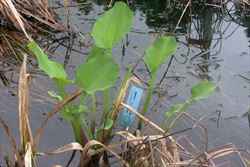
habit of young plants (Photo: Simon Brooks)
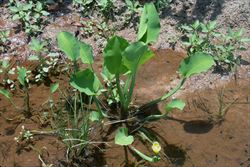
habit in flower (Photo: Simon Brooks)

leaves (Photo: Jason Weber)

close-up of leaf blade (Photo: Jason Weber)
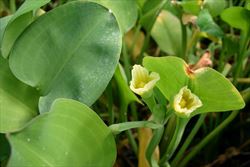
flowers and leaves (Photo: Jason Weber)

close-up of flower (Photo: Simon Brooks)
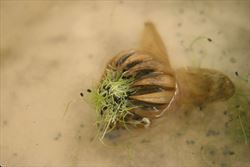
germinating seeds (Photo: Jason Weber)

seedlings (Photo: Jason Weber)
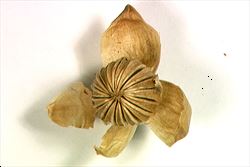
mature fruiting 'capsule' (Photo: Joe Vitelli and Barbara Madigan)
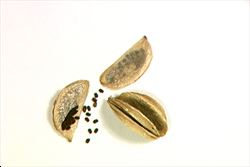
'capsule' segments and seeds (Photo: Joe Vitelli and Barbara Madigan)
Scientific Name
Limnocharis flava (L.) Buch.
Synonyms
Alisma flava L.Limnocharis emarginata Humb. & Bonp.
Family
Limnocharitaceae
Common Names
bur head, limnocharis, sawah flower rush, sawah lettuce, velvetleaf, yellow burr head, yellow burr-head, yellow burrhead, yellow sawah lettuce, yellow velvetleaf
Origin
This species is native to Mexico, the Caribbean (i.e. Cuba, the Dominican Republic, Grenada and Haiti), Central America (i.e. Costa Rica, Nicaragua and Panama) and tropical South America (Venezuela, Brazil, Bolivia, Colombia, Ecuador, Peru, northern Argentina and Paraguay).
Cultivation
Limnocharis (Limnocharis flava) has been cultivated as an ornamental aquatic plant in tropical regions.
Naturalised Distribution
Limnocharis (Limnocharis flava) was first found to be naturalised in Australia in 2001, when a population was detected in the Cairns area. Small infestations have since been located in other parts of northern Queensland (i.e. near Feluga, Mossman and Townsville).
It is also widely naturalised in south-eastern Asia (i.e. Cambodia, Vietnam, Brunei, Singapore, Thailand, Indonesia and Malaysia).
Habitat
A potential weed of wetter tropical environments. It inhabits freshwater bodies of water (i.e. dams, lakes and ponds), slow moving waterways, wetlands, swamps, marshes, irrigation channels, drainage ditches and ponded crops (e.g. rice).
Habit
A long-lived (i.e. perennial), clump-forming, aquatic herbaceous plant that is rooted to the ground and emerges above the water surface (i.e. it is emergent). It usually grows 20-120 cm tall.
Distinguishing Features
- a long-lived aquatic herbaceous plant growing 20-120 cm tall.
- its fleshy leaves arise from the base of the plant on long three-angled stalks.
- these leaves have rounded blades (5-30 cm long and 4-25 cm wide) with entire margins.
- its yellow flowers have three petals and are borne in loose clusters at the top of long flower stalks.
- its rounded fruiting 'capsules' split into several floating segments when mature.
Stems and Leaves
The very large and somewhat fleshy leaves arise from the base of the plant, and are borne in clusters along a short thick upright (i.e. erect) stem (about 3cm long and 3 cm wide).
The leaves are hairless (i.e. glabrous) and contain a milky sap (i.e. latex). They are borne on long three-angled stalks (i.e. trigonous petioles) 5-90 cm long and have rounded (i.e. orbicular) leaf blades. The leaf blades (5-30 cm long and 4-25 cm wide) have blunt tips (i.e. obtuse apices) and entire or wavy (i.e. undulate) margins.
Flowers and Fruit
The flowers are borne in loose clusters (containing 2-15 flowers) at the top of long stalks (20-120 cm long). These upright flower stalks (i.e. erect peduncles) emerge from the base of the plant and are three-angled (i.e. trigonous), like the leaf stalks (i.e. petioles). About one to four of these flowering stalks are produced amongst each cluster of leaves. The individual flowers (2-4 cm across) are borne on short thick stalks (i.e. pedicels), 2-7 cm long, that emerge from the same point at the top of the flowering stems (i.e. they are arranged in an umbel). There are usually some small papery bracts present amongst the flower stalks (i.e. pedicels). Each flower has three large pale yellow petals (2-3 cm long and 1-2 cm wide), three overlapping green sepals (15-20 mm long and 10-15 mm wide), and a cluster of numerous bright yellow stamens at its centre. Flowering occurs throughout the year, depending on conditions (i.e. it usually flowers during wetter periods).
The upright flower stalks (i.e. peduncles) begin to droop as the fruit mature, and the persistent sepals become enlarged and enclose the developing fruit. The fruit are rounded 'capsules' (i.e. spherical follicles), 15-20 mm across, that split up into several (10-20) floating segments when mature. Each segment is semi-circular in shape and contains numerous ridged seeds (1-1.5 mm long) that are dark brown in colour and horseshoe-shaped.
Reproduction and Dispersal
This species reproduces by seed and vegetatively via creeping underground stems (i.e. rhizomes). Small plants (i.e. ramets) are sometimes also produced at the tops of the flowering stems.
The seeds and vegetative shoots are usually spread by water, but may also be dispersed in dumped garden and aquarium waste.
Environmental Impact
Yellow burrhead (Limnocharis flava) is regarded as a potentially significant environmental weed in Queensland, and has been targeted for eradication from this state. It was also recently listed as a priority environmental weed in at least one Natural Resource Management region and is included on the Nothern Australia Quarantine Strategy (NAQS) list.
Yellow burrhead (Limnocharis flava) is also very invasive in other parts of the world and in listed in the Global Invasive Species Database (GISD).
Legislation
Declared noxious in the following states and territories:
- New South Wales: Class 1 - a state prohibited weed. The presence of the weed on land must be notified to the local control authority and the weed must be fully and continuously suppressed and destroyed (throughout the entire state).
- Northern Territory: C - not to be introduced into the Territory.
- Queensland: Class 1 - introduction into the state is prohibited, and landowners must take reasonable steps to keep land free of this species (throughout the entire state). It is also illegal to sell a declared plant or its seed in this state.
- Western Australia: Prohibited - on the prohibited species list and not permitted entry into the state.
Management
For information on the management of this species see the following resources:
- the Biosecurity Queensland Fact Sheet on this species, which is available online at http://www.dpi.qld.gov.au.
- the Northern Territory Department of Natural Resources, Environment and The Arts Agnote on this species, which is available online at http://www.nt.gov.au/weeds.
Similar Species
Yellow burrhead (Limnocharis flava) is similar to monochoria (Monochoria cyanea ), pickerel weed (Pontederia cordata) and water hyacinth (Eichhornia crassipes) when it is not in flower. It is also relatively similar to sagittaria (Sagittaria platyphylla). These species can be distinguished by the following differences:
- yellow burrhead (Limnocharis flava) is rooted to the substrate with leaves that have three-angled stalks (i.e. trigonous petioles) and broad, rounded (i.e. orbicular) leaf blades with blunt tips (i.e. obtuse apices). Its relatively large flowers (2-4 cm across) are yellow and borne in loose clusters.
- monochoria (Monochoria cyanea) is rooted to the substrate with leaves that have rounded stalks (i.e. terete petioles) and oval (i.e. elliptic) to egg-shaped (i.e. ovate) leaf blades with pointed tips (i.e. acute apices). Its relatively large flowers (2-4 cm across) are dark blue or purplish and borne in elongated clusters.
- pickerel weed (Pontederia cordata) is rooted to the substrate with leaves that have rounded stalks (i.e. terete petioles) and egg-shaped (i.e. ovate) or elongated (i.e. lanceolate) leaf blades with pointed tips (i.e. acute apices). Its relatively small flowers (less than 2 cm across) are usually blue to violet (with two small yellowish spots) and borne in dense elongated clusters.
- water hyacinth (Eichhornia crassipes ) is usually a free-floating plant with leaves that have thickened, spongy, stalks (i.e. inflated petioles) and oval (i.e. elliptic) to rounded (i.e. orbicular) leaf blades with blunt tips (i.e. obtuse apices). Its very showy flowers (4-6 cm across) are blue, purplish or mauve (with a yellowish spot) and borne in dense elongated clusters.
- sagittaria (Sagittaria platyphylla) is rooted to the substrate with leaves that have three-angled stalks (i.e. trigonous petioles) and lance-shaped (i.e. lanceolate) or narrowly egg-shaped (i.e. narrowly ovate) leaf blades with pointed tips (i.e. acute apices). Its relatively large flowers (up to 3 cm across) are white (rarely pinkish) and borne in three's in elongated clusters.

